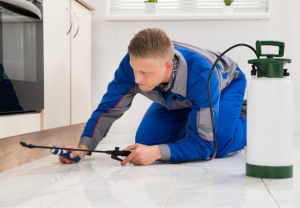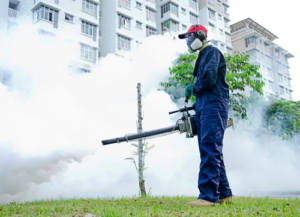Pest control involves preventing pests from damaging your property and, when necessary, controlling them to acceptable levels. Preventing pests may require a combination of tactics, such as aeration or watering, trapping, natural enemies and/or chemical controls.
Eliminating food and shelter for pests by regularly removing garbage, keeping compost and garden areas closed and eliminating clutter can greatly reduce their numbers. Prevention also means taking care not to introduce foreign species that could become pests. Click Here to know more.

Rodents are small mammals that belong to the order Rodentia. They have short limbs and long tails and use their sharp front teeth, called incisors, to gnaw food, excavate burrows, and defend themselves against predators. The incisors continuously grow, which helps explain why rodents have such prominent front teeth. The incisors and jaw musculature also differentiate rodents from other mammalian species, including moles, squirrels, and hamsters, which have needle-like teeth and do not belong to the order Rodentia.
Rats and mice are some of the most familiar rodent pests. They have global distributions and are associated with billions of dollars in crop damage each year. In addition, they are secondary hosts for diseases that affect humans, such as the bubonic plague. Rodents also cause fires by chewing on electrical wires.
The primary goal of pest control for rodents is to prevent their entry into buildings. This can be achieved by sealing entry points and removing food, water, and shelter. The best long-term solution is to incorporate an integrated pest management approach that includes sanitation, exclusion and repellents.
Preventing rodents starts with inspecting your property and identifying potential entry points. Look for signs of rodent activity such as droppings in and around pantry items, pet food and water bowls, trash cans, and compost containers. Also check for areas where rodents may be nesting, such as a pile of shredded paper or fabric. Reduce attracting factors by storing food in containers with tight lids, keeping kitchen garbage tightly closed, and avoiding over-fertilizing gardens. Remove shrubbery and weeds that may serve as cover or hiding places for rodents.
If prevention methods fail, there are a number of low-hazard pest control options for controlling rodents. Some options include removing accessible food sources, closing access routes, and using snap traps to kill or remove rodents as needed.
Another option is to attract natural predators of rodents to your property. The type of predator that is introduced depends on the specific problem, but some examples include owls, snakes, and hawks. This method can be more expensive than pesticides, but it is an effective and environmentally friendly solution.
Insects
Insects that bite, sting, or carry diseases can be harmful to people and livestock. They also damage crops and interfere with agricultural production. Pest control involves preventive and reactive measures to control pest populations through habitat modification, sanitation, proper identification, and, when necessary, the use of chemicals.
In order to be effective, pesticides must be used properly. This means preparing the treatment area correctly, targeting specific areas of the plant or home, and being thorough. Treatments may need to be repeated. It is important to remember that most pests do not live in isolation; they are often part of an ecosystem with other insects, birds, mammals, nematodes, and microorganisms. For this reason, it is best to use pest control as a component of an overall management program rather than as a standalone solution.
Some insects are natural enemies of other pests and can be used in biological pest control. The process of finding suitable natural enemies requires a thorough knowledge of the biology of the pest and its potential predators and parasites. The natural enemy is then selected and collected, quarantined to eliminate pathogens that could be transmitted to people or other plants, and released in a location where the pest population and the natural enemy are both abundant.
Several types of natural enemies are available for the control of garden pests, including predatory mites and nematodes. The most commonly used natural enemies of caterpillars and other soft-bodied pests are products containing the bacteria Bacillus thuringiensis (Bt). When sprayed on plants, Bt kills caterpillars and other pests by paralyzing their guts with a protein that is produced by the bacterium. Unlike chemical insecticides, Bt is not toxic to other animals, plants, or humans.
Many insects that feed on plants are beneficial, providing pollination or feeding on diseased parts of a plant that would otherwise rot. For example, bees are essential to the garden for their role in pollination, and many fruit trees benefit from insect pest control provided by birds that feed on caterpillars and other leaf-chewing pests.
When a homeowner sees an insect pest, they often have a knee-jerk reaction to spray it with insecticide. However, the most effective way to eliminate pests is by using prevention and control techniques that do not involve dangerous chemicals.
Termites
Termites are wood-destroying pests that devour the material on which houses and other structures are built. Their silent presence in your home can be devastating if not addressed quickly, and they can destroy structures of any size, compromising their structural integrity. Liquid termiticides are used to eliminate these pests and are applied to the soil around a building, and also directly on infested wood. The chemicals in these products are absorbed by the termites and shared with the rest of the colony, leading to widespread extermination.
Termite infestations can go unnoticed for years, consuming the wood within walls and floors before being discovered. Signs of a termite problem include wood that sounds hollow when tapped, and a musty or moldy smell. You may also see mud tubes (tiny, mud-colored tunnels) connecting an underground nest to a structure or piece of furniture, and a small mound of fecal pellets in the corner of a room.
When you suspect a termite infestation, contact your local pest control company immediately. A professional inspection and treatment plan will be devised to eradicate the pests and prevent their return. A trench is often dug around the perimeter of your property to form a shield, and follow-up consultations are performed to ensure the pests are gone for good.
A termite infestation is typically caused by water leaks in a house that allow rotting and dampness to enter crawl spaces, where wood infested with these pests can be found. Preventing a termite infestation can be as simple as fixing leaks and making sure wood that touches the ground is rot-resistant, such as pressure-treated lumber. Stacking firewood away from your home and keeping wood-to-ground contact to a minimum can also reduce the risk of a termite infestation, as can using metal screens for vents in crawl spaces.
Drywood termite colonies can be treated by drilling holes 10 inches apart in the infested wood and pouring termiticide into them. For more difficult cases, a pest control company can install an Advance Termite Baiting System, which uses bait stations to monitor and control the pests without the need for chemical treatments.
Bed Bugs
Bed bugs are reddish-brown and oval in shape. Their bodies are about the size of an apple seed, although they look more like a lentil to the naked eye. Immature bed bug nymphs are lighter in color. Both adults and nymphs can crawl rapidly over surfaces. They prefer dark, tight places where they can hide until ready to feed. Bed bugs can hide in the cracks and crevices of headboards, in mattress and box spring seams and even the smallest spaces around electric outlets or behind picture frames.
They are active at night and tend to suck blood through their needle-like mouthparts. They pierce the skin with these mouthparts to extract the blood, which they inject with saliva to ensure proper flow. The bed bugs then scurry back to their hiding place, where they can remain undetected for weeks or months.
The first step in controlling bed bugs is to find where they are hiding. Bed bug traps placed under mattresses and sofas can help. Identifying the rooms where the bed bugs are active can also be helpful, since these pests often travel to other areas in your home by hitching rides on clothing or luggage.
Once you know where the bed bugs are, it is time to get rid of them. Wash all infested bedding and clothing, using the hottest water possible. Alternatively, seal items in plastic and leave them in the sun for an hour to kill them. If you are having difficulty eliminating them, you can spray common hiding spots with a surface pesticide that is registered to control bed bugs (follow label directions carefully).
Other steps in the elimination process include:
Keep in mind that some species of bed bugs actually prey on bats or birds and may bite humans. Entomologists can determine whether these species are present, as well as their preferred hosts, and recommend appropriate control measures. If the wild host is the culprit, exclusion of the roost or nest can eliminate them. If the preferred host is a household pet, it may need to be relocated.





